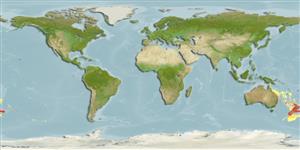Common names from other countries
Lớp cá viên khẩu (Myxini) (hagfishes) >
Myxiniformes (Hagfishes) >
Myxinidae (Hagfishes) > Eptatretinae
Etymology: Eptatretus: hepta (Gr.), seven; tretos (Gr.), perforated (i.e., with holes), referring to seven gill apertures on what would later be described as Homea banksii (=E. cirrhatus) [range within genus is 6-14 pairs of gill apertures]. (See ETYFish); cirrhatus: Latin for having tendrils, i.e., presumed to be a species of “lamprey” with barbels. (See ETYFish).
More on author: Forster.
Environment: milieu / climate zone / depth range / distribution range
Sinh thái học
Biển Tầng đáy biển sâu; không di cư; Mức độ sâu 0 - 1100 m (Ref. 89422), usually 40 - 700 m (Ref. 31276). Deep-water
Western Pacific: southern and eastern Australia and New Zealand.
Bộ gần gũi / Khối lượng (Trọng lượng) / Age
Maturity: Lm ? range ? - ? cm
Max length : 97.0 cm TL con đực/không giới tính; (Ref. 101563)
Short description
Khóa để định loại | Hình thái học | Sinh trắc học
Các tia vây lưng cứng (tổng cộng) : 0; Các vây lưng mềm (tổng cộng) : 0; Tia cứng vây hậu môn: 0; Tia mềm vây hậu môn: 0. This species differs from all its congeners except E. caribbeaus, E. goliath, E. menezesi and E. strahani by having 7 pairs of gill pouches and three-cusp multicusps on the anterior and posterior rows of cusps. It differs from E. caribbeaus in number of anterior unicusps (8-11 vs. 11-13), posterior unicusps (7-9 vs. 10-11), total cusps (43-51 vs. 54-58) and prebranchial pores (16-20 vs. 13-15); from E. goliath in number of anterior unicusps (8-11 vs. 11-13), total cusps (43-51 vs. 54) and trunk pores (46-53 vs. 57-58); from E. menezesi in number of posterior unicusps (7-9 vs. 9-12), total cusps (43-51 vs. 52-60), tail pores (10-14 vs. 14-18); from E. strahani by its number of prebranchial pores (16-20 vs. 13-16) (Ref. 85052).
Occurs on soft bottoms of the continental slope (Ref. 7300). Able to form locally abundant populations and is often associated with inshore reefs (Ref. 85052).
Life cycle and mating behavior
Maturities | Sự tái sinh sản | Spawnings | Egg(s) | Fecundities | Ấu trùng
Copulatory organ absent. The gonads of hagfishes are situated in the peritoneal cavity. The ovary is found in the anterior portion of the gonad, and the testis is found in the posterior part. The animal becomes female if the cranial part of the gonad develops or male if the caudal part undergoes differentiation. If none develops, then the animal becomes sterile. If both anterior and posterior parts develop, then the animal becomes a functional hermaphrodite. However, hermaphroditism being characterised as functional needs to be validated by more reproduction studies (Ref. 51361 ).
Fernholm, B., 1998. Hagfish systematics. p. 33-44. In J.M. Jørgensen, J.P. Lomholt, R.E. Weber and H. Malte (eds.) The biology of hagfishes. Chapman & Hall, London. 578 p. (Ref. 31276)
IUCN Red List Status (Ref. 130435)
CITES (Ref. 128078)
Not Evaluated
Threat to humans
Harmless
Human uses
Các nghề cá: Tính thương mại
Các công cụ
Special reports
Download XML
Các nguồn internet
Estimates based on models
Preferred temperature (Ref.
115969): 7.8 - 21, mean 12.3 (based on 188 cells).
Phylogenetic diversity index (Ref.
82804): PD
50 = 0.5000 [Uniqueness, from 0.5 = low to 2.0 = high].
Bayesian length-weight: a=0.00295 (0.00163 - 0.00533), b=2.95 (2.78 - 3.12), in cm Total Length, based on LWR estimates for this species & (Sub)family-body (Ref.
93245).
Mức dinh dưỡng (Ref.
69278): 2.0 ±0.00 se; based on food items.
Thích nghi nhanh (Ref.
120179): thấp, thời gian nhân đôi của chủng quần tối thiểu là 4.5 - 14 năm (Fec assumed to be <100).
Fishing Vulnerability (Ref.
59153): High vulnerability (59 of 100).
